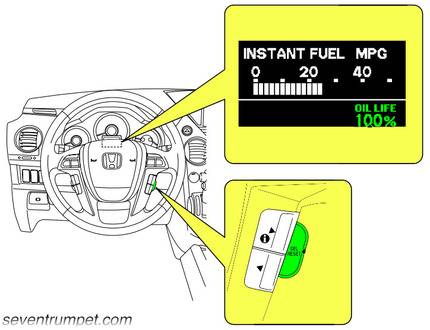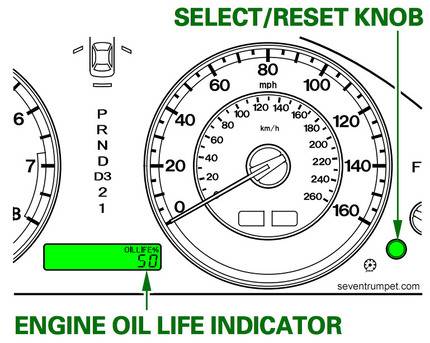Honda Pilot Oil Life/Wrench Light – Meaning & Resetting
Last Updated on January 19, 2024 by Nick
All right, so today we’re working on a 2012 Honda Pilot. It’s a pretty cool vehicle and, shall we say, family-friendly with the third-row seat. They have off-road capabilities because they’re all-wheel drive. So today, I wanted to show just a little tip about resetting the oil life or wrench light after doing maintenance service on Honda Pilot.
So if you get a wrench light, that means you have to reset the maintenance reminder. If you go to the dealership, but they’re not resetting it, you have to reset it yourself. So let me show you how to do that.
Table of Contents
How To Reset Oil Life in Honda Pilot (2006-2015)
You can reset the oil life by using the knob on the instrument cluster. Depending on your vehicle trim level, each model year may have a different button layout. So let’s check this out!
- Get in the car and turn it on
- Press the SELECT/RESET knob on the instrument cluster repeatedly until the menu shows up the OIL LIFE
- Hold the knob in for 10 seconds and then it should start flashing in a couple of seconds
- Release and then push the knob again for another 5 seconds and that will reset it
Resetting With Steering Button (2009-2015)
Time needed: 3 minutes
In this section, I’m going to show you how to get rid of that little light; it looks like a bit of a wrench on your dashboard; that’s the maintenance reminder light. So now that you’re doing your maintenance, I’m going to show you how to turn it off.
- First, turn the ignition key to the ON position
If your vehicle has an ignition button, push the POWER button twice without stepping on the brake pedal
- Show the OIL LIFE screen
Press the SEL/RESET button repeatedly until Oil Life appears on the display

- Pull and hold the SEL/RESET button
Pull the SEL/RESET button for 10 seconds or until a little screen pops up and it says oil life reset
- Select RESET
Once the Oil Life Reset screen pops up, press the ▲ button to highlight RESET and then pull the reset button to perform the oil life reset
For your info, this operation work for the first and second generations of the Honda Pilot (2006, 2007, 2008, 2009, 2010, 2011, 2012, 2013, 2014, 2015 model years). For the latest model, you can reach it here.
What Does the Honda Pilot Wrench Light Mean?
A question we hear a lot it’s got Honda is, what is the yellow wrench that lights up on my dash? The yellow wrench-shaped light in the instrument cluster is a maintenance minder. It shows that your Honda Pilot needs routine maintenance. In addition, this system monitors engine oil life and other operating conditions. You can reset this light by taking your car to a Honda service center. However, if you are unsure what the yellow wrench-shaped light on the instrument cluster means, read on to learn more.
Maintenance Minder or Oil Life Monitors
The Honda Maintenance Minder system keeps track of your car’s engine oil life so you won’t have to. It not only alerts you to the due date of maintenance but also saves you money. It calculates the life of your engine oil based on driving habits and conditions. Adjusting your driving habits won’t have to worry about when your oil needs to be changed.
The Maintenance Minder system automatically adjusts the maintenance intervals based on your car’s engine conditions. It does this by monitoring engine operations, driving habits, and climate. The maintenance intervals for the engine oil and tires on your Honda Pilot are automatically calculated based on your driving habits and the life of your tires. You can view these maintenance schedules using the Maintenance Minder system link. The benefits of following Maintenance Minder recommendations are numerous.
Other engine operating conditions
The Honda Pilot has a 3.5-liter V6 engine that requires no scheduled maintenance for 100,000 miles or more. It also requires normal fluid and filter replacements. For its first tune-up, the Honda Pilot gets an inspected water pump, valve adjustment, camshaft timing belt, and new spark plugs. Honda also said that the VCM would help the car run more efficiently by cutting the losses associated with valve operation.
The Pilot’s V-6 engine has Variable Cylinder Management (VCM) technology and can run with either three or six cylinders. The variable valve timing feature changes the intake valve lift profile and duration. It also alternates between closed and open valves. Other engine operating conditions for Honda Pilot
Why is my Honda Check Engine light on?
If your Honda Pilot has a check engine light, the first step to taking care of it is to get it checked by a mechanic. The Check Engine light comes on when a problem is found in the transmission or flashes. If the light does not come on, the transmission fluid level is low, or there is a problem with the sensor. Fortunately, the most common cause of this problem is a fluid leak.
A misfire in the ignition or fuel system is typically to blame, but there are other causes. Problems with the VVT or the EGR system, which recycles exhaust gasses back into the combustion chamber, can also cause a Pilot to have a check engine light. Additionally, the engine will run rough if the crank sensor is faulty. Having the car inspected by a mechanic as soon as possible is important, as this problem could lead to more expensive repairs down the road.
FAQ – Honda Pilot Maintenance
0W-20 Synthetic oil is the recommended lubricant for the 2014 Honda Pilot in all climates. With a filter, the car holds 4.5 quarts or 4.2 quarts without one. The drain plug requires a torque of 29 ft/lbs.
Timing belts were standard equipment on all Honda Pilot engines and variants from 2003 to 2017. According to Honda, you should replace this belt every 60,000 to 100,000 miles, although your mileage may vary based on your vehicle’s age and mileage use.
The payload capacity of the 2014 Honda Pilot is 1,633 pounds, while the towing capability is 2,000 pounds. At 4,800 RPM, the 250-hp 3.5-Liter V6 engine produces 253 pounds of torque.
So there you go. Hopefully, this will save somebody a trip to the dealer because you can do it yourself. Thanks for reading; check out my other content, and please comment if you have any questions. I do appreciate it and until next time!


What do you do if you were unable to change the oil and the mileage reads in the negative. I have the wrench light on, changed the oil myself, and cannot get the oil life or check engine to reset.
2016 is super easy! Set display panel to oil life. Hold the reset button located on steering wheel for 5 to 10 seconds. Display panel will beep and then show ‘cancel’ on top of ‘reset’. Arrow down to reset, and hit the reset button on steering wheel again. It will take about 3 to 5 seconds for the computer to react, then *poof* ‘Oil Life 100%’
2016 Honda Pilot is super easy! Set display panel to oil life. Hold the reset button located on steering wheel for 5 to 10 seconds. Display panel will beep and then show ‘cancel’ on top of ‘reset’. Arrow down to reset, and hit the reset button on steering wheel again. It will take about 3 to 5 seconds for the computer to react, then *poof* ‘Oil Life 100%’